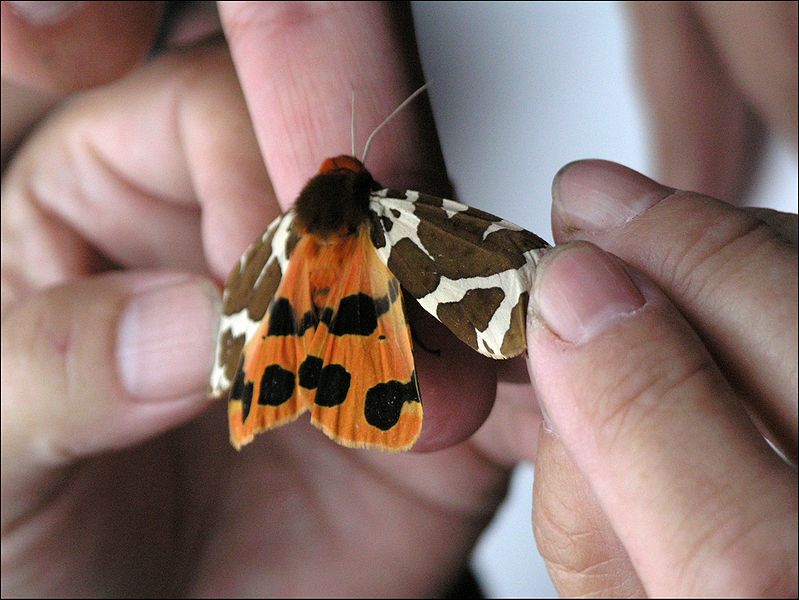Garden Tiger Moth (showing the hindwing pattern)
Peter Martin writes:
“Writing the recent article about hairy caterpillars of the Oak Processionary Moth reminded me of the brown hairy caterpillars of the Garden Tiger Moth that I was always coming across during my youth.
The hairs from these creatures are loaded with histamines and can cause nasty irritations if handled. If more than one is kept together in captivity, they can be cannibalistic (don’t ask me how one can chew the other one without getting a mouthful of those nasty hairs).
I haven’t seen any of these hairy monsters (often called “woolly bears”) for many years and there is now real concern that they could become extinct.
Caterpillar of the Garden Tiger Moth
“Butterfly Conservation” has a moth-night each year and this year it is making a particular request for anyone spotting a Garden Tiger Moth during the period from the 8th to the 10th August to report it.
More information on National Moth Night can be found here.
I am sure that, if you spot any of these caterpillars at any time and are sure that they are not one of the other hairy moth creatures, “Butterfly Conservation” would like to hear from you.”
Photos credits: here.



i found one on my allotment as i never seen one of these i decided to look it up in the net
Found quite a few on piel Island off Roa Island near Barrow in furness Cumbria on 18.5.2014
found one in garden somerset 26/05/14
We have had 3 or 4 living in our front garden so far this year. They must be regulars because we found a tiger moth on the front path last year.. Didn’t realise they are so rare
This looks suspiciously like the critter crawling up my hand while I was pruning today, though it’s Sept 3rd so rather late? What else could it be?
Peter Martin, our butterfly expert, says that it could be a “Woolly Bear” – the caterpillars emerge during July/August and go through the winter and then pupate in June/July the following year. Hope this helps!
We have found a Garden Tiger as he was crossing a busy road, he would have been squished! My grandchildren saved him, and we decided to look him up. I guess we will release him since he is rare. But they would like to feed him first. What does he eat?
Thanks for your interest in the blog. Our butterfly and moth expert, Peter Martin, says that the “woolly bear” caterpillars will eat almost any type of low-growing foliage and will even climb to some higher plants such as hollyhocks and sunflowers. He also mentioned that an interesting feature about the Garden Tiger Moth itself is that the colouration and patterns of the wings can vary from one moth to another!
My wife saw one & photographed one today. We were at Flamboro Head near Bridlington.
I saw one of these today on the grassland overlooking Newgale beach in Pembrokeshire. My dogs had a sniff and backed off but I let it crawl on my jacket so I could take photos haha
I saw a caterpillar like this today when I was running on the cycle path from Lochwinnoch to Paisley in Renfrewshire Scotland